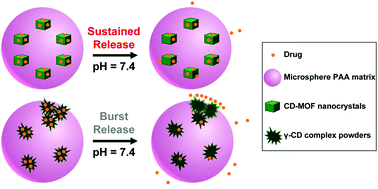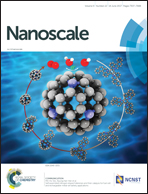Composite CD-MOF nanocrystals-containing microspheres for sustained drug delivery†
Abstract
Metal–organic frameworks (MOFs), which are typically embedded in polymer matrices as composites, are emerging as a new class of carriers for sustained drug delivery. Most of the MOFs and the polymers used so far in these composites, however, are not pharmaceutically acceptable. In the investigation reported herein, composites of γ-cyclodextrin (γ-CD)-based MOFs (CD-MOFs) and polyacrylic acid (PAA) were prepared by a solid in oil-in-oil (s/o/o) emulsifying solvent evaporation method. A modified hydrothermal protocol has been established which produces efficiently at 50 °C in 6 h micron (5–10 μm) and nanometer (500–700 nm) diameter CD-MOF particles of uniform size with smooth surfaces and powder X-ray diffraction patterns that are identical with those reported in the literature. Ibuprofen (IBU) and Lansoprazole (LPZ), both insoluble in water and lacking in stability, were entrapped with high drug loading in nanometer-sized CD-MOFs by co-crystallisation (that is more effective than impregnation) without causing MOF crystal degradation during the loading process. On account of the good dispersion of drug-loaded CD-MOF nanocrystals inside polyacrylic acid (PAA) matrices and the homogeneous distribution of the drug molecules within these crystals, the composite microspheres exhibit not only spherical shapes and sustained drug release over a prolonged period of time, but they also demonstrate reduced cell toxicity. The cumulative release rate for IBU (and LPZ) follows the trend: IBU-γ-CD complex microspheres (ca. 80% in 2 h) > IBU microspheres > IBU-CD-MOF/PAA composite microspheres (ca. 50% in 24 h). Importantly, no burst release of IBU (and LPZ) was observed from the CD-MOF/PAA composite microspheres, suggesting an even distribution of the drug as well as strong drug carrier interactions inside the CD-MOF. In summary, these composite microspheres, composed of CD-MOF nanocrystals embedded in a biocompatible polymer (PAA) matrix, constitute an efficient and pharmaceutically acceptable MOF-based carrier for sustained drug release.

- This article is part of the themed collection: National Nanotechnology Day


 Please wait while we load your content...
Please wait while we load your content...